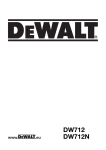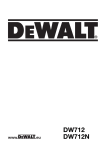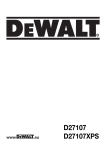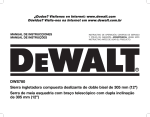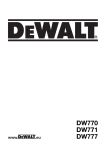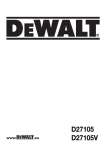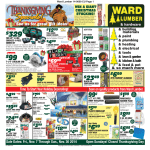Download DeWalt 780 Technical data
Transcript
www. .eu DWS780 Figure 1A c d b e a f g i h j w k l v m t n u o p s q r Figure 1B x hh y aa gg z bb ff ee cc dd 1 Figure 2 Figure 3 jj ii Figure 5 Figure 4 kk ll Figure 6 Figure 7 nn mm 2 Figure 8 Figure 9 oo Figure 10A Figure 10B b a pp a cc Figure 10C Figure 10D ss tt qq rr pp cc 3 Figure 11 Figure 12 vv xx yy k zz v a1 a2 ww uu s a3 u a4 a5 Figure 14 Figure 13 a6 u Figure 16 Figure 15 u 4 a7 a8 Figure 17A Figure 17B Figure 18 Figure 19 Figure 20 Figure 21 A B 5 Figure 22 Figure 23 “A” Figure 24B Figure 24A n ll q q n Figure 25B Figure 25A ss ss n 6 n Figure 26A Figure 26B Figure 27 a Figure 28B Figure 28A m a9 o o 7 EN GL I S H MITRE SAW DWS780 Congratulations! An estimation of the level of exposure to vibration should also take into account the times when the tool is switched off or when it is running but not actually doing the job. This may significantly reduce the exposure level over the total working period. You have chosen a DEWALT tool. Years of experience, thorough product development and innovation make DEWALT one of the most reliable partners for professional power tool users. Identify additional safety measures to protect the operator from the effects of vibration such as: maintain the tool and the accessories, keep the hands warm, organisation of work patterns. Technical Data Voltage U.K. & Ireland Type Power input Blade diameter Blade bore Blade body thickness Max. blade speed U.K. & Ireland Max. cross-cut capacity 90° Max. mitre capacity 45° Max. depth of cut 90° Max. depth of bevel cross-cut 45° Mitre (max. positions) Bevel (max. positions) 0° mitre Resulting width at max. height 112 mm Resulting width at max. height 110 mm Resulting height at max. width 345 mm 45° mitre left Resulting width at max. height 112 mm Resulting height at max. width 244 mm 45° mitre right Resulting width at max. height 112 mm Resulting height at max. width 244 mm 45° bevel left Resulting width at max. height 63 mm Resulting height at max. width 345 mm 45° bevel right Resulting width at max. height 62 mm Resulting height at max. width 345 mm Automatic blade brake time Weight LPA KPA LWA KWA (sound pressure) (sound pressure uncertainty) (sound power) (sound power uncertainty) W mm mm mm min-1 min-1 mm mm mm mm left right left right DWS780 230 230/115 10 1675 305 30 1.8 1900–3800 1600–3600 349 244 112 56 50° 60° 49° 49° mm mm mm 299 303 76 mm mm 200 76 mm mm 211 76 mm mm 268 44 mm mm s kg 193 28 < 10 25.4 DEWALT declares that these products described under Technical Data are in compliance with: 2006/42/EC, EN 61029-1, EN 61029-2-9. dB(A) dB(A) dB(A) dB(A) 93 3.0 100 3.0 The undersigned is responsible for compilation of the technical file and makes this declaration on behalf of DEWALT. VAC VAC Fuses Europe U.K. & Ireland U.K. & Ireland 230 V tools 230 V tools 115 V tools 10 Amperes, mains 13 Amperes, in plugs 16 Amperes, mains Definitions: Safety Guidelines The definitions below describe the level of severity for each signal word. Please read the manual and pay attention to these symbols. DANGER: Indicates an imminently hazardous situation which, if not avoided, will result in death or serious injury. WARNING: Indicates a potentially hazardous situation which, if not avoided, could result in death or serious injury. CAUTION: Indicates a potentially hazardous situation which, if not avoided, may result in minor or moderate injury. NOTICE: Indicates a practice not related to personal injury which, if not avoided, may result in property damage. Denotes risk of electric shock. Denotes risk of fire. EC-Declaration of Conformity MACHINERY DIRECTIVE DWS780 These products also comply with Directive 2004/108/EC and 2011/65/EU. For more information, please contact DEWALT at the following address or refer to the back of the manual. Vibration total values (triax vector sum) determined according to EN 61029: Vibration emission value ah ah = Uncertainty K = m/s² m/s² < 2.5 1.5 The vibration emission level given in this information sheet has been measured in accordance with a standardised test given in EN 61029 and may be used to compare one tool with another. It may be used for a preliminary assessment of exposure. WARNING: The declared vibration emission level represents the main applications of the tool. However if the tool is used for different applications, with different accessories or poorly maintained, the vibration emission may differ. This may significantly increase the exposure level over the total working period. 32 Horst Grossmann Vice President Engineering and Product Development DEWALT, Richard-Klinger-Strasse 11, D-65510, Idstein, Germany 01.11.2011 ENGLI SH Safety Instructions WARNING! When using electric tools basic safety precautions should always be followed to reduce the risk of fire, electric shock and personal injury including the following. Read all these instructions before attempting to operate this product and save these instructions. SAVE THIS MANUAL FOR FUTURE REFERENCE General Safety Rules 1. Keep work area clear. Cluttered areas and benches invite injuries. 2. Consider work area environment. Do not expose the tool to rain. Do not use the tool in damp or wet conditions. Keep the work area well lit (250–300 Lux). Do not use the tool where there is a risk of causing fire or explosion, e.g., in the presence of flammable liquids and gases. 3. Guard against electric shock. Avoid body contact with earthed surfaces (e.g., pipes, radiators, cookers and refrigerators). When using the tool under extreme conditions (e.g., high humidity, when metal swarf is being produced, etc.), electric safety can be improved by inserting an isolating transformer or a (FI) earth-leakage circuit-breaker. 4. Keep other persons away. Do not let persons, especially children, not involved in the work, touch the tool or the extension cord and keep them away from the work area. 5. Store idle tools. When not in use, tools must be stored in a dry place and locked up securely, out of reach of children. 6. Do not force the tool. It will do the job better and safer at the rate to which it was intended. 7. Use the right tool. Do not force small tools to do the job of a heavy duty tool. Do not use tools for purposes not intended; for example do not use circular saws to cut tree limbs or logs. 8. Dress properly. Do not wear loose clothing or jewellery, as these can be caught in moving parts. Non-skid footwear is recommended when working outdoors. Wear protective hair covering to contain long hair. 9. Use protective equipment. Always use safety glasses. Use a face or dust mask if working operations create dust or flying particles. If these particles might be considerably hot, also wear a heat-resistant apron. Wear ear protection at all times. Wear a safety helmet at all times. 10. Connect dust extraction equipment. If devices are provided for the connection of dust extraction and collecting equipment, ensure these are connected and properly used. 11. Do not abuse the cord. Never yank the cord to disconnect it from the socket. Keep the cord away from heat, oil and sharp edges. Never carry the tool by its cord. 12. Secure work. Where possible use clamps or a vice to hold the work. It is safer than using your hand and it frees both hands to operate the tool. 13. Do not overreach. Keep proper footing and balance at all times. 14. Maintain tools with care. Keep cutting tools sharp and clean for better and safer performance. Follow instructions for lubricating and changing accessories. Inspect tools periodically and if damaged have them repaired by an authorized service facility. Keep handles and switches dry, clean and free from oil and grease. 15. Disconnect tools. When not in use, before servicing and when changing accessories such as blades, bits and cutters, disconnect tools from the power supply. 16. Remove adjusting keys and wrenches. Form the habit of checking to see that adjusting keys and wrenches are removed from the tool before operating the tool. 17. Avoid unintentional starting. Do not carry the tool with a finger on the switch. Be sure that the tool is in the “off” position before plugging in. 18. Use outdoor extension leads. Before use, inspect the extension cable and replace if damaged. When the tool is used outdoors, use only extension cords intended for outdoor use and marked accordingly. 19. Stay alert. Watch what you are doing. Use common sense. Do not operate the tool when you are tired or under the influence of drugs or alcohol. 20. Check for damaged parts. Before use, carefully check the tool and mains cable to determine that it will operate properly and perform its intended function. Check for alignment of moving parts, binding of moving parts, breakage of parts, mounting and any other conditions that may affect its operation. A guard or other part that is damaged should be properly repaired or replaced by an authorized service centre unless otherwise indicated in this instruction manual. Have defective switches replaced by an authorized service centre. Do not use the tool if the switch does not turn it on and off. Never attempt any repairs yourself. WARNING! The use of any accessory or attachment or performance of any operation with this tool other than those recommended in this instruction manual may present a risk of personal injury. 21. Have your tool repaired by a qualified person. This electric tool complies relevant safety rules. Repairs should only be carried out by qualified persons using original spare parts; otherwise this may result in considerable danger to the user. Additional Safety Rules for Mitre Saws • The machine is provided with a special configured power supply cord which can only be replaced by the manufacturer or its authorised service agent. • Do not use the saw to cut other materials than those recommended by the manufacturer. • Do not operate the machine without guards in position, or if guards do not function or are not maintained properly. • Ensure that the arm is securely fixed when performing bevel cuts. • Keep the floor area around the machine level, well-maintained and free of loose materials, e.g., chips and cut-offs. • Use correctly sharpened saw blades. Observe the maximum speed mark on the saw blade. • Select the correct blade for the material to be cut. • Make sure all locking knobs and clamp handles are tight before starting any operation. • Never place either hand in the blade area when the saw is connected to the electrical power source. • Never attempt to stop a machine in motion rapidly by jamming a tool or other means against the blade; serious accidents can occur. • Before using any accessory consult the instruction manual. The improper use of an accessory can cause damage. • Use a holder or wear gloves when handling a saw blade or rough material. • Ensure that the saw blade is mounted correctly before use. • Make sure that the blade rotates in the correct direction. • Do not use blades of larger or smaller diameter than recommended. For the proper blade rating refer to the technical data. Use only the blades specified in this manual, complying with EN 847-1. • Do consider applying specially designed noise-reduction blades. 33 EN GL I S H • Do not use HIGH SPEED STEEL blades. • Do not use cracked or damaged saw blades. Turn the machine on and start new cutting operation with reduced feed force. • Do not use any abrasive or diamond discs. • Never cut light alloy, especially magnesium. • Never use your saw without the kerf plate. • Whenever the situation allows, mount the machine to a bench using bolts with a diameter of 8 mm and 80 mm in length. • Before each cut ensure that the machine is stable. • Raise the blade from the kerf in the workpiece prior to releasing the switch. • Ensure the operator is adequately trained in the use, adjustment and operation of the machine. • Do not wedge anything against the fan to hold the motor shaft. • Before working select the correct saw blade for the material to be cut. • The blade guard on your saw will automatically raise when the head up-lock release lever is pushed and the arm is brought down; it will lower over the blade as the arm is raised. • Use only saw blades where the speed marked on the saw blade is at least equal to the speed marked on the rating blade. • Never raise the blade guard manually unless the saw is switched off. The guard can be raised by hand when installing or removing saw blades or for inspection of the saw. • Check periodically that the motor air slots are clean and free of chips. • Replace the kerf plate when worn. Refer to service parts list included. • Disconnect the machine from the mains before carrying out any maintenance work or when changing the blade. • Never perform any cleaning or maintenance work when the machine is still running and the head is not in the upper position. • If you use an LED to indicate the cutting line, make sure that the LED is of class 2 according to EN 62471. Do not replace an LED diode with a different type. If damaged, have the LED repaired by an authorised repair agent. • The front section of the guard is louvered for visibility while cutting. Although the louvers dramatically reduce flying debris, they are openings in the guard and safety glasses should be worn at all times when viewing through the louvers. • Connect the saw to a dust collection device when sawing wood. Always consider factors which influence exposure of dust such as: – type of material to be machined (chip board produces more dust than wood); • Ensure before each cut that the machine is located on an even and stable surface to prevent movement. Residual Risks The following risks are inherent to the use of saws: – Injuries caused by touching the rotating parts. In spite of the application of the relevant safety regulations and the implementation of safety devices, certain residual risks cannot be avoided. These are: – Impairment of hearing. – Risk of accidents caused by the uncovered parts of the rotating saw blade. – Risk of injury when changing the blade. – Risk of squeezing fingers when opening the guards. – Health hazards caused by breathing dust developed when sawing wood, especially oak, beech and MDF. The following factors increase the risk of breathing problems: – No dust extractor connected when sawing wood. – Insufficient dust extraction caused by uncleaned exhaust filters. Markings on Tool The following pictograms are shown on the tool: – sharpness of the saw blade; Read instruction manual before use. – correct adjustment of the saw blade; – dust extractor with air velocity not less than 20m/s. Ensure that the local extraction as well as hoods, baffles and chutes are properly adjusted. Wear ear protection. • Please be aware of the following factors influencing exposure to noise: Wear eye protection. – use saw blades designed to reduce the emitted noise; Carrying point. – use only well sharpened saw blades. • Machine maintenance shall be conducted periodically. Keep hands away from blade. • Provide adequate general or localized lighting. • Ensure that any spacers and spindle rings are suitable for the purpose as stated in this manual. • Refrain from removing any cut-offs or other parts of the workpiece from the cutting area while the machine is running and the saw head is not in the upper position. Do not stare directly into the light source. • Never cut workpieces shorter than 200 mm. Hazardous optical radiation. • Without additional support the machine is designed to accept the maximum workpiece size for cross-cutting: – Maximum height: 112 mm DATE CODE POSITION (FIG. 1A) – Maximum width: 345 mm The date code (i), which also includes the year of manufacture, is printed into the housing. – Maximum length: 600 mm Example: 2012 XX XX – Longer workpiece needs to be supported by suitable additional support, e.g. DE7080-XJ support or DE7023-XJ or DE7033-XJ legstand. Always clamp the workpiece safely. • In case of an accident or machine failure, immediately turn the machine off and disconnect machine from the power source. • Report the failure and mark the machine in suitable form to prevent other people from using the defective machine. • When the saw blade is blocked due to abnormal feed force during cutting, turn the machine off and disconnect it from power supply. Remove the workpiece and ensure that the saw blade runs free. 34 Year of Manufacture Package Contents The package contains: 1 Assembled mitre saw 1 Blade wrench 1 Saw blade 1 Dustbag ENGLI SH 1 Material clamp Fig. 6 1 Instruction manual mm. DE7053-XJ Dustbag 1 Exploded drawing • Check for damage to the tool, parts or accessories which may have occurred during transport. • Take the time to thoroughly read and understand this manual prior to operation. Description (fig. 1A–8) WARNING: Never modify the power tool or any part of it. Damage or personal injury could result. Fig. 1A a. Lower guard b. Head up-lock release lever c. Operating handle d. Carrying handle e. Motor housing f. Motor end cap g. Rail lock knob h. Rail set screw adjustment i. Date code j. Rails k. Bevel scale l. Lock down pin m. Fence adjustment knob n. Fence o. Base fence p. Hand indentation q. Table r. Bench mounting holes s. Mitre scale Fig. 7 nn. DE7023-XJ / DE7033-XJ Leg stand Fig. 8 oo. DE7025-XJ Clamp brackets INTENDED USE Your DEWALT DWS780 Mitre Saw has been designed for professional cutting of wood, wood products and plastics. It performs the sawing operations of cross-cutting, bevelling and mitring easily, accurately and safely. This unit is designed for use with a nominal blade diameter 305 mm carbide tip blade. DO NOT use under wet conditions or in the presence of flammable liquids or gases. These mitre saws are professional power tools. DO NOT let children come into contact with the tool. Supervision is required when inexperienced operators use this tool. WARNING! Do not use the machine for purposes other than intended. • This product is not intended for use by persons (including children) suffering from diminished physical, sensory or mental abilities; lack of experience, knowledge or skills unless they are supervised by a person responsible for their safety. Children should never be left alone with this product. Electrical Safety The electric motor has been designed for one voltage only. Always check that the power supply corresponds to the voltage on the rating plate. Your DEWALT tool is double insulated in accordance with EN 61029; therefore no earth wire is required. t. Dust duct inlet u. Mitre lock handle v. Mitre latch button w. Kerf plate Fig. 1B WARNING: 115 V units have to be operated via a fail-safe isolating transformer with an earth screen between the primary and secondary winding. If the supply cord is damaged, it must be replaced by a specially prepared cord available through the DEWALT service organisation. x. Trigger switch Mains Plug Replacement (U.K. & Ireland Only) y. XPSTM on/off switch If a new mains plug needs to be fitted: z. Wing nut • Safely dispose of the old plug. aa. Depth adjustment screw • Connect the brown lead to the live terminal in the plug. bb. Grooving stop • Connect the blue lead to the neutral terminal. cc. Blade wrench dd. Base ee. Bevel lock knob ff. 0° bevel stop gg. Belt cover hh. Electronic speed control dial Optional accessories Fig. 2 ii. DE7080-XJ Extension work support Fig. 3 jj. DE7051-XJ Adjustable length stop Fig. 4 kk. DE7082-XJ Workpiece clamp WARNING: No connection is to be made to the earth terminal. Follow the fitting instructions supplied with good quality plugs. Recommended fuse: 13 A. Fitting a Mains Plug to 115 V Units (U.K. and Ireland Only) • The plug fitted should be comply with BS EN 60309 (BS4343), 16 Amps, earthing contact position 4h. WARNING: Always ensure that the cable clamp is correctly and securely fitted to the sheath of the cable. Using an Extension Cable If an extension cable is required, use an approved 3–core extension cable suitable for the power input of this tool (see Technical Data).The minimum conductor size is 1.5 mm2; the maximum length is 30 m. When using a cable reel, always unwind the cable completely. Fig. 5 ll. DE7084-XJ Crown molding fence 35 EN GL I S H ASSEMBLY AND ADJUSTMENTS WARNING: To reduce the risk of injury, turn unit off and disconnect machine from power source before installing and removing accessories, before adjusting or changing set-ups or when making repairs. Be sure the trigger switch is in the OFF position. An accidental startup can cause injury. Unpacking (fig. 1A, 9) 1. Open the box and lift the saw out by the convenient carrying handle (d), as shown in figure 9. 2. Place the saw on a smooth, flat surface. 3. Release the rail lock knob (g), and push the saw head back to lock it in the rear position. 4. Press down lightly on the operating handle (c) and pull out the lock down pin (l). 5. Gently release the downward pressure and hold the operating handle, allowing it to rise to its full height. Bench Mounting (fig. 1A) Holes (r) are provided in all four feet to facilitate bench mounting. Two different-sized holes are provided to accommodate different sizes of screws. Use either hole; it is not necessary to use both. Always mount your saw firmly to a stable surface to prevent movement. To enhance the tool’s portability, it can be mounted to a piece of 12.7 mm (1/2") or thicker plywood which can then be clamped to your work support or moved to other job sites and reclamped. NOTE: If you elect to mount your saw to a piece of plywood, make sure that the mounting screws don’t protrude from the bottom of the wood. The plywood must sit flush on the work support. When clamping the saw to any work surface, clamp only on the clamping bosses where the mounting screw holes are located. Clamping at any other point will interfere with the proper operation of the saw. CAUTION: To prevent binding and inaccuracy, be sure the mounting surface is not warped or otherwise uneven. If the saw rocks on the surface, place a thin piece of material under one saw foot until the saw sits firmly on the mounting surface. Changing or Installing a New Saw Blade REMOVING THE BLADE (FIG. 10A–10D) WARNING: To reduce the risk of injury, turn unit off and disconnect machine from power source before installing and removing accessories, before adjusting or changing set-ups or when making repairs. Be sure the trigger switch is in the OFF position. An accidental startup can cause injury. • Never depress the spindle lock button while the blade is under power or coasting. • Do not cut light alloy and ferrous metal (containing iron or steel) or masonry or fibre cement product with this mitre saw. • Depress the head up-lock release lever (b) to release the lower guard (a), then raise the lower guard as far as possible. 1. Unplug the saw. 2. Raise the arm to the upper position and raise the lower guard (a) as far as possible. 3. Depress the spindle lock button (qq) while carefully rotating the saw blade by hand until the lock engages. 4. Keeping the button depressed, use the other hand and the wrench provided (cc) to loosen the blade screw. (Turn clockwise, left-hand threads.) 5. Remove the blade screw (pp), outer clamp washer (rr) and blade (ss). The inner clamp washer (tt) may be left on the spindle. INSTALLING A BLADE (FIG. 10A–10D) 1. Unplug the saw. 2. With the arm raised and the lower guard held open, place the blade on the spindle, and seat it on the inner blade clamp with the teeth at the bottom of the blade pointing toward the back of the saw. 36 3. Assemble the outer clamp washer onto the spindle. 4. Install the blade screw and, engaging the spindle lock, tighten the screw firmly with wrench provided (turn counterclockwise, left-hand threads). WARNING! Be aware the saw blade shall be replaced in the described way only. Only use saw blades as specified under Technical Data; Cat. no.: DT4260 is suggested. Transporting the Saw (fig. 1A, 1B) WARNING: To reduce the risk of serious personal injury, ALWAYS lock the rail lock knob, mitre lock handle, bevel lock handle, lock down pin and fence adjustment knobs before transporting saw. Never use guards for transporting or lift up. In order to conveniently carry the mitre saw, a carrying handle (d) has been included on the top of the saw arm. • To transport the saw, lower the head and depress the lock down pin (l). • Lock the rail lock knob with the saw head in the front position, lock the mitre arm in the full left mitre angle, slide the fence (n) completely inward and lock the bevel lock knob (ee) with the saw head in the vertical position to make the tool as compact as possible. • Always use the carrying handle (d) or the hand indentations (p). Features and Controls WARNING: To reduce the risk of injury, turn unit off and disconnect machine from power source before installing and removing accessories, before adjusting or changing set-ups or when making repairs. Be sure the trigger switch is in the OFF position. An accidental startup can cause injury. MITRE CONTROL (FIG. 11) The mitre lock handle (u) and mitre latch button (v) allow you to mitre your saw to 60° right and 50° left. To mitre the saw, lift the mitre lock handle, push the mitre latch button and set the mitre angle desired on the mitre scale (s). Push down on the mitre lock handle to lock the mitre angle. BEVEL LOCK KNOB (FIG. 1B) The bevel lock allows you to bevel the saw 49° left or right. To adjust the bevel setting, turn the knob (ee) counterclockwise. The saw head bevels easily to the left or to the right once the 0° bevel override knob is pulled. To tighten, turn the bevel lock knob clockwise. 0° BEVEL OVERRIDE (FIG. 1B) The bevel stop override (ff) allows you to bevel the saw to the right past the 0° mark. When engaged, the saw will automatically stop at 0° when brought up from the left. To temporarily move past 0° to the right, pull the bevel lock knob (ee). Once the knob is released, the override will be reengaged. The bevel lock knob can be locked out by twisting the knob 180°. When at 0°, the override locks in place. To operate the override, bevel the saw slightly to the left. 45° BEVEL STOP OVERRIDE (FIG. 12) There are two bevel stop override levers, one on each side of the saw. To bevel the saw, left or right, past 45°, push the 45° bevel override lever (a1) rearward. When in the rearward position, the saw can bevel past these stops. When the 45° stops are needed, pull the 45° bevel override lever forward. CROWN BEVEL PAWLS (FIG. 12) When cutting crown molding laying flat, your saw is equipped to accurately and rapidly set a crown stop, left or right (refer to Instructions for Cutting Crown Molding Laying Flat and Using the Compound Features). The crown bevel pawl (a3) can be rotated to contact the crown adjustment screw. To reverse the crown bevel pawl, remove the retaining screw, the 22.5° bevel pawl (a2) and the 30° crown bevel pawl (a3). Flip the crown bevel pawl (a3) so the 33.86° text is facing up. Reattach the screw to secure the 22.5° bevel pawl and the crown bevel pawl. The accuracy setting will not be affected. ENGLI SH 22.5° BEVEL PAWLS (FIG. 12) BEVEL POINTER ADJUSTMENT (FIG. 12) Your saw is equipped to rapidly and accurately set a 22.5° bevel, left or right. The 22.5° bevel pawl (a2) can be rotated to contact the crown adjustment screw (zz). If the bevel pointers (yy) do not indicate zero, loosen each screw (xx) that holds each bevel pointer in place and move them as necessary. Ensure the 0° bevel is correct and the bevel pointers are set before adjusting any other bevel angle screws. RAIL LOCK KNOB (FIG. 1A) The rail lock knob (g) allows you to lock the saw head firmly to keep it from sliding on the rails (j). This is necessary when making certain cuts or when transporting the saw. GROOVING STOP (FIG. 1B) The grooving stop (bb) allows the depth of cut of the blade to be limited. The stop is useful for applications such as grooving and tall vertical cuts. Rotate the grooving stop forward and adjust the depth adjustment screw (aa) to set the desired depth of cut. To secure the adjustment, tighten the wing nut (z). Rotating the grooving stop to the rear of the saw will bypass the grooving stop feature. If the depth adjustment screw is too tight to loosen by hand, the provided blade wrench (cc) can be used to loosen the screw. LOCK DOWN PIN (FIG. 1A) WARNING: The lock down pin should be used ONLY when carrying or storing the saw. NEVER use the lock down pin for any cutting operation. To lock the saw head in the down position, push the saw head down, push the lock down pin (l) in and release the saw head. This will hold the saw head safely down for moving the saw from place to place. To release, press the saw head down and pull the pin out. SLIDE LOCK LEVER (FIG. 13, 23) The slide lock lever (a6) places the saw in a position to maximize cutting of base molding when cut vertically as shown in figure 23. Adjustment Your mitre saw is fully and accurately adjusted at the factory at the time of manufacture. If readjustment due to shipping and handling or any other reason is required, follow the instructions below to adjust your saw. Once made, these adjustments should remain accurate. MITRE SCALE ADJUSTMENT (FIG. 11, 14) 1. Unlock the mitre lock handle (u) and swing the mitre arm until the mitre latch button (v) locks it at the 0° mitre position. Do not lock the mitre lock handle. BEVEL STOP 45° RIGHT AND LEFT ADJUSTMENT (FIG. 1B, 12) To adjust the right 45° bevel stop: 1. Loosen the bevel lock knob (ee) and pull the 0° bevel stop (ff) to override the 0° bevel stop. 2. When the saw is fully to the right, if the bevel pointer (yy) does not indicate exactly 45°, turn the left 45° bevel adjustment screw (a4) with the 13 mm (1/2") blade wrench (cc) until the bevel pointer indicates 45°. To adjust the left 45° bevel stop: 1. Loosen the bevel lock knob and tilt the head to the left. 2. If the bevel pointer does not indicate exactly 45°, turn the right 45° bevel adjustment screw until the bevel pointer reads 45°. ADJUSTING THE BEVEL STOP TO 22.5° (OR 30°) (FIG. 1B, 12) NOTE: Adjust the bevel angles only after performing the 0° bevel angle and bevel pointer adjustment. To set the left 22.5° bevel angle, flip out the left 22.5° bevel pawl (a2). Loosen the bevel lock knob (ee) and tilt the head fully to the left. If the bevel pointer (yy) does not indicate exactly 22.5°, turn the crown adjustment screw (zz) contacting the pawl with a 10 mm (7/16") wrench until the bevel pointer reads 22.5°. To adjust the right 22.5° bevel angle, flip out the right 22.5° bevel pawl. Loosen the bevel lock knob and pull the 0° bevel stop (ff) to override the 0° bevel stop. When the saw is fully to the right, if the bevel pointer does not indicate exactly 22.5°, turn the crown adjustment screw contacting the pawl with a 10 mm (7/16") wrench until the bevel pointer indicates exactly 22.5°. FENCE ADJUSTMENT (FIG. 1A) The upper part of the fence can be adjusted to provide clearance, allowing the saw to bevel to a full 49° both left and right. 1. To adjust each fence (n), loosen the fence adjustment knob (m) and slide the fence outward. 2. Make a dry run with the saw turned off and check for clearance. 2. Place a square against the saw’s fence and blade, as shown. (Do not touch the tips of the blade teeth with the square. To do so will cause an inaccurate measurement.) 3. Adjust the fence to be as close to the blade as practical to provide maximum workpiece support, without interfering with arm up and down movement. 3. If the saw blade is not exactly perpendicular to the fence, loosen the four screws (ww) that hold the mitre scale (s) and move the mitre lock handle and the scale left or right until the blade is perpendicular to the fence, as measured with the square. 4. Tighten the fence adjustment knob securely. 4. Retighten the four screws. Pay no attention to the reading of the mitre pointer (uu) at this time. MITRE POINTER ADJUSTMENT (FIG. 11) 5. When the bevel operations are complete, relocate the fence. For certain cuts, it may be desirable to bring the fences closer to the blade. To do so, back the fence adjustment knobs (m) out two turns and move the fences closer to the blade past the normal limit, then tighten the fence adjustment knobs. Make a dry cut first to ensure the blade does not contact the fences. 1. Unlock the mitre lock handle (u) to move the mitre arm to the zero position. NOTE: The tracks of the fences can become clogged with sawdust. Use a brush or some low pressure air to clear the guide grooves. 2. With the mitre lock handle unlocked, allow the mitre latch to snap into place as you rotate the mitre arm to zero. GUARD ACTUATION AND VISIBILITY (FIG. 1A) 3. Observe the mitre pointer (uu) and mitre scale (s) shown in figure 11. If the pointer does not indicate exactly zero, loosen the mitre pointer screw (v v) holding the pointer in place, reposition the pointer and tighten the screw. BEVEL SQUARE TO TABLE ADJUSTMENT (FIG. 1A, 1B, 12, 15) 1. To align the blade square to the table, lock the arm in the down position with the lock down pin (l). 2. Place a square against the blade, ensuring the square is not on top of a tooth. 3. Loosen the bevel lock knob (ee) and ensure the arm is firmly against the 0° bevel stop. 4. Rotate the 0° bevel adjustment screw (a5) with the 13 mm (1/2") blade wrench (cc) as necessary so that the blade is at 0° bevel to the table. The lower guard (a) on your saw has been designed to automatically uncover the blade when the arm is brought down and to cover the blade when the arm is raised. The guard can be raised by hand when installing or removing saw blades or for inspection of the saw. NEVER RAISE THE LOWER GUARD MANUALLY UNLESS THE BLADE IS STOPPED. KERF PLATE ADJUSTMENT (FIG. 1A) To adjust the kerf plates (w), loosen the screws holding the kerf plates in place. Adjust so that the kerf plates are as close as possible without interfering with the blade’s movement. If a zero kerf width is desired, adjust the kerf plates as close to each other as possible. They can now be cut slowly with the saw blade to give the smallest gap possible between the blade and the kerf plates. RAIL GUIDE ADJUSTMENT (FIG. 1A) Regularly check the rails (j) for play or clearance. The right rail can be adjusted with the set screw (h). To reduce clearance, use a 4 mm hex wrench and rotate the set screw clockwise gradually while sliding the saw head back and forth. 37 EN GL I S H MITRE LOCK ADJUSTMENT (FIG. 1A, 16) The mitre lock rod (a7) should be adjusted if the table of the saw can be moved when the mitre lock handle is locked (down). 1. Put the mitre lock handle (u) in the unlocked (up) position. 2. Using a 13 mm (1/2") open end wrench, loosen the lock nut (a8) on the mitre lock rod. 3. Using a slotted screwdriver, tighten the mitre lock rod by turning it clockwise as shown in figure 16. Turn the lock rod until it is snug, then turn counterclockwise one turn. 4. Re-lock the mitre lock to a non-detented measurement on the mitre scale – for example, 34° – and make sure the table will not rotate. 5. Tighten lock nut. Prior to Operation • Install the appropriate saw blade. Do not use excessively worn blades. The maximum rotation speed of the tool must not exceed that of the saw blade. Do not use any abrasive blades. • ALWAYS MAKE DRY RUNS (UNPOWERED) BEFORE FINISH CUTS SO THAT YOU CAN CHECK THE PATH OF THE BLADE. DO NOT CROSS HANDS, AS SHOWN IN FIGURE 17B. • Keep both feet firmly on the floor and maintain proper balance. As you move the mitre arm left and right, follow it and stand slightly to the side of the saw blade. • Sight through the guard louvers when following a pencil line. Switching On and Off (fig. 1B) To turn the saw on, depress the trigger switch (x). To turn the tool off, release the trigger switch. Allow the blade to spin up to full operating speed before making the cut. Release the trigger switch and allow the brake to stop the blade before raising the saw head. A hole is provided in the trigger switch for insertion of a padlock to lock the saw off. • Do not attempt to cut excessively small pieces. SETTING THE VARIABLE SPEED (FIG. 1B) • Allow the blade to cut freely. Do not force. The speed control dial (hh) can be used for advance setting of the required range of speed. • Allow the motor to reach full speed before cutting. • Make sure all locking knobs and clamp handles are tight. • Secure the workpiece. • Although this saw will cut wood and many nonferrous materials, these operating instructions refer to the cutting of wood only. The same guidelines apply to the other materials. Do not cut ferrous (iron and steel) materials, fibre cement or masonry with this saw! • Make sure to use the kerf plate. Do not operate the machine if the kerf slot is wider than 10 mm. • Turn the speed control dial (hh) to the desired range, which is indicated by a number. • Use high speeds for sawing soft materials such as wood. Use low speeds for sawing metal. Use of XPSTM LED Worklight System (fig. 1A, 1B) NOTE: The mitre saw must be connected to a power source. OPERATION The XPSTM LED Worklight System is equipped with an on/off switch (y). The XPSTM LED Worklight System is independent of the mitre saw’s trigger switch. The light does not need to be on in order to operate the saw. Instructions for Use To cut through an existing pencil line on a piece of wood: WARNING: Always observe the safety instructions and applicable regulations. WARNING: To reduce the risk of injury, turn unit off and disconnect machine from power source before installing and removing accessories, before adjusting or changing set-ups or when making repairs. Be sure the trigger switch is in the OFF position. An accidental startup can cause injury. Refer to Saw Blades under Optional Accessories to select the blade that best fits your needs. Ensure the machine is placed to satisfy your ergonomic conditions in terms of table height and stability. The machine site shall be chosen so that the operator has a good overview and enough free surrounding space around the machine that allows handling of the workpiece without any restrictions. To reduce effects of vibration make sure the environment temperature is not too cold, the machine and accessories are well maintained and the workpiece size is suitable for this machine. 1. Turn on the XPSTM system, then pull down on the operating handle (c) to bring the saw blade close to the wood. The shadow of the blade will appear on the wood. 2. Align the pencil line with the edge of the blade’s shadow. You may have to adjust the mitre or bevel angles in order to match the pencil line exactly. Basic Saw Cuts (fig. 1A, 1B, 18, 19) If the slide feature is not used, ensure the saw head is pushed back as far as possible and the rail lock knob (g) is tightened. This will prevent the saw from sliding along its rails as the workpiece is engaged. Cutting of multiple pieces is not recommended but can be done safely by ensuring that each piece is held firmly against the table and fence. STRAIGHT VERTICAL CROSSCUT 1. Set and lock the mitre arm at zero, and hold the wood firmly on the table (q) and against the fence (n). The attention of UK users is drawn to the “woodworking machines regulations 1974” and any subsequent amendments. 2. With the rail lock knob (g) tightened, turn on the saw by squeezing the trigger switch (x). Plug the saw into any household 60 Hz power source. Refer to the nameplate for voltage. Be sure the cord will not interfere with your work. 3. When the saw comes up to speed, lower the arm smoothly and slowly to cut through the wood. Let the blade come to a full stop before raising arm. Proper Body and Hand Position (fig. 17A, 17B) WARNING: To reduce the risk of serious personal injury, ALWAYS use proper hand position as shown in fig. 17A. WARNING: To reduce the risk of serious personal injury, ALWAYS hold securely in anticipation of a sudden reaction. • Never place hands near cutting area. Place hands no closer than 152 mm (6") from the blade. • Hold the workpiece tightly to the table and the fence when cutting. Keep hands in position until the trigger has been released and the blade has completely stopped. 38 SLIDING CROSSCUT When cutting anything larger than a 51 x 150 mm (2" x 6" [51 x 105 mm (2" x 4") at 45° mitre]) workpiece, use an out-down-back motion with the rail lock knob (g) loosened (fig. 18). Pull the saw out toward you, lower the saw head down toward the workpiece, and slowly push the saw back to complete the cut. Do not allow the saw to contact the top of the workpiece while pulling out. The saw may run toward you, possibly causing personal injury or damage to the workpiece. ENGLI SH MITRE CROSSCUT The mitre angle angle is often 45° for making corners, but can be set anywhere from zero to 50° left or 60° right. Proceed as for a straight vertical crosscut. When performing a mitre cut on workpieces wider than 51 x 105 mm (2" x 4") that are shorter in length, always place the longer side against the fence (fig. 19). BEVEL CUT Bevel angles can be set from 49° right to 49° left and can be cut with the mitre arm set between 50° left or 60° right. Refer to the Features and Controls section for detailed instructions on the bevel system. should be fully inserted into the base. Ensure this groove is fully inserted into the base of the mitre saw. If the groove is visible, the clamp will not be secure. 2. Rotate the clamp 180° toward the front of the mitre saw. 3. Loosen the knob to adjust the clamp up or down, then use the fine adjust knob to firmly clamp the workpiece. NOTE: Place the clamp on the opposite side of the base when beveling. ALWAYS MAKE DRY RUNS (UNPOWERED) BEFORE FINISH CUTS TO CHECK THE PATH OF THE BLADE. ENSURE THE CLAMP DOES NOT INTERFERE WITH THE ACTION OF THE SAW OR GUARDS. 1. Loosen the bevel lock (ee), and move the saw to the left or right as desired. It is necessary to move the fence (n) to allow clearance. Tighten the fence adjustment knob (m) after positioning the fences. Support for Long Pieces (fig. 7) 2. Tighten the bevel lock firmly. For best results, use the DE7023-XJ or DE7033 leg stands (nn) to extend the table width of your saw. Support long workpieces using any convenient means such as sawhorses or similar devices to keep the ends from dropping. At some extreme angles, the right or left side fence might have to be removed. Refer to Fence Adjustment in the Adjustments section for important information on adjusting the fences for certain bevel cuts. To remove the left or right fence, unscrew the fence adjustment knob (m) several turns and slide the fence out. GROOVING (FIG. 1B) Your saw is equipped with a grooving stop (bb), depth adjustment screw (aa) and wing nut (z) to allow for groove cutting. • Flip the grooving stop (bb) towards the front of the saw. • Adjust the wing nut (z) and depth adjustment screw (aa) to set the depth of the groove cut. • Place a piece of scrap material of approx. 5 cm between fence and workpiece in order to perform a straight groove cut. QUALITY OF CUT The smoothness of any cut depends on a number of variables, such as the material being cut, blade type, blade sharpness and rate of cut. When smoothest cuts are desired for molding and other precision work, a sharp (60 tooth carbide) blade and a slower, even cutting rate will produce the desired results. WARNING: Ensure that the material does not move or creep while cutting; clamp it securely in place. Always let the blade come to a full stop before raising arm. If small fibers of wood still split out at the rear of the workpiece, stick a piece of masking tape on the wood where the cut will be made. Saw through the tape and carefully remove tape when finished. Clamping the Workpiece (fig. 4) WARNING: A workpiece that is clamped, balanced and secure before a cut may become unbalanced after a cut is completed. An unbalanced load may tip the saw or anything the saw is attached to, such as a table or workbench. When making a cut that may become unbalanced, properly support the workpiece and ensure the saw is firmly bolted to a stable surface. Personal injury may occur. WARNING: The clamp foot must remain clamped above the base of the saw whenever the clamp is used. Always clamp the workpiece to the base of the saw – not to any other part of the work area. Ensure the clamp foot is not clamped on the edge of the base of the saw. CAUTION: Always use a work clamp to maintain control and reduce the risk of personal injury and workpiece damage. Use the material clamp (kk) provided with your saw. The left or right fence will slide from side to side to aid in clamping. Other aids such as spring clamps, bar clamps or C-clamps may be appropriate for certain sizes and shapes of material. TO INSTALL CLAMP 1. Insert it into the hole behind the fence. The clamp should be facing toward the back of the mitre saw. The groove on the clamp rod ALWAYS SUPPORT LONG PIECES. Cutting Picture Frames, Shadow Boxes And Other Four-Sided Projects (fig. 20, 21) Try a few simple projects using scrap wood until you develop a “feel” for your saw. Your saw is the perfect tool for mitring corners like the one shown in figure 20. Sketch A in figure 21 shows a joint made with the bevel adjustment method. The joint shown can be made using either method. • Using bevel adjustment: – The bevel for the two boards is adjusted to 45° each, producing a 90° corner. – The mitre arm is locked in the zero position and the bevel adjustment is locked at 45°. – The wood is positioned with the broad flat side against the table and the narrow edge against the fence. • Using mitre adjustment: – The same cut can be made by mitring right and left with the broad surface against the fence. Cutting Trim Molding And Other Frames (fig. 21) Sketch B in figure 21 shows a joint made by setting the mitre arm at 45° to mitre the two boards to form a 90° corner. To make this type of joint, set the bevel adjustment to zero and the mitre arm to 45°. Once again, position the wood with the broad flat side on the table and the narrow edge against the fence. The two sketches in figure 21 are for four-sided objects only. As the number of sides changes, so do the mitre and bevel angles. The chart below gives the proper angles for a variety of shapes, assuming that all sides are of equal length. NUMBER OF SIDES MITRE OR BEVEL ANGLE 4 45° 5 36° 6 30° 7 25.7° 8 22.5° 9 20° 10 18° For a shape that is not shown in the chart, use the following formula: 180° divided by the number of sides equals the mitre (if the material is cut vertically) or bevel angle (if the material is cut laying flat). Cutting Compound Mitres (fig. 22) A compound mitre is a cut made using a mitre angle and a bevel angle at the same time. This is the type of cut used to make frames or boxes with slanting sides like the one shown in figure 22. WARNING: If the cutting angle varies from cut to cut, check that the bevel lock knob and the mitre lock handle are securely locked. These must be locked after making any changes in bevel or mitre. 39 EN GL I S H The chart (Table 1) shown below will assist you in selecting the proper bevel and mitre settings for common compound mitre cuts. INSTRUCTIONS FOR CUTTING CROWN MOULDING LAYING FLAT AND USING THE COMPOUND FEATURES (FIG. 24A) • Select the desired angle A (fig. 22) of your project and locate that angle on the appropriate arc in the chart. 1. Moulding should lay flat with the broad back surface down on the saw table. • From that point follow the chart straight down to find the correct bevel angle and straight across to find the correct mitre angle. 2. Place the top of the moulding against the fence. 3. The settings below are for 45° sprung crown moulding. • Set your saw to the prescribed angles and make a few trial cuts. Practise fitting the cut pieces together. Example: To make a 4-sided box with 26° exterior angles (Angle A, fig. 22), use the upper right arc. Find 26° on the arc scale. Follow the horizontal intersecting line to either side to get mitre angle setting on saw (42°). Likewise, follow the vertical intersecting line to the top or bottom to get the bevel angle setting on the saw (18°). Always try cuts on a few scrap pieces of wood to verify the settings on the saw. SET THIS MITER ANGLE ON SAW ANGLE OF SIDE OF BOX (ANGLE"A") 8 SIDED BOX OUTSIDE CORNER Left side Bevel left 30° Mitre table set at right 35.26° Save left end of cut Bevel right 30° Mitre table set at left 35.26° Save left end of cut Right side Bevel right 30° Mitre table set at left 35.26° Save right end of cut Bevel left 30° Mitre table set at right 35.26° Save right end of cut 4. The settings below are for crown moulding with 52° angles at the top and 38° angles at the bottom. SQUARE BOX 6 SIDED BOX INSIDE CORNER SET THIS BEVEL ANGLE ON SAW INSIDE CORNER OUTSIDE CORNER Left side Bevel left 33.9° Mitre table set at right 31.62° Save left end of cut Bevel right 33.9° Mitre table set at left 31.62° Save left end of cut Right side Bevel right 33.9° Mitre table set at left 31.62° Save right end of cut Bevel left 33.9° Mitre table set at right 31.62° Save right end of cut ALTERNATIVE METHOD FOR CUTTING CROWN MOULDING (FIG. 5) Cutting crown moulding using this method does not require a bevel cut. Minute changes in the mitre angle can be made without affecting the bevel angle. When corners other than 90° are encountered, the saw can be quickly and easily adjusted for them. Use of the DW7084 crown moulding fence accessory (ll) is highly recommended because of its degree of accuracy and convenience (fig. 5). INSTRUCTIONS FOR CUTTING CROWN MOULDING ANGLED BETWEEN THE FENCE AND BASE OF THE SAW FOR ALL CUTS (FIG. 24B) 1. Angle the moulding so the bottom of the moulding (the part which goes against the wall when installed) is against the fence and the top of the moulding is resting on the saw table. Cutting Base Moulding (fig. 13, 23) • Straight 90° cuts: – Position the wood against the fence and hold it in place as shown in figure 23. Turn on the saw, allow the blade to reach full speed and lower the arm smoothly through the cut. 2. The angled “flats” on the back of the moulding must rest squarely on the fence and saw table. INSIDE CORNER OUTSIDE CORNER CUTTING BASE MOULDING FROM 76 mm UP TO 171 mm (3" UP TO 6.75") HIGH VERTICALLY AGAINST THE FENCE Left side Mitre right at 45° Save right side of cut Mitre left at 45° Save right side of cut NOTE: Use the slide lock lever (a6), shown in figure 13, when cutting base moulding measuring from 76 mm to 171 mm (3" to 6.75") high vertically against the fence. Right side Mitre left at 45° Save left side of cut Mitre right at 45° Save left side of cut Position material as shown in figure 23. All cuts should be made with the back of the moulding against the fence and with the bottom of the moulding against the table. Left side Right side INSIDE CORNER OUTSIDE CORNER Mitre left 45° Save left side of cut Mitre right 45° Save left side of cut Mitre right 45° Save right side of cut Mitre left 45° Save right side of cut Material up to 171 mm (6.75") can be cut as described above. Cutting Crown Moulding (fig. 1A, 5, 24A, 24B) Your mitre saw is well suited to the task of cutting crown moulding. In order to fit properly, crown moulding must be compound mitred with extreme accuracy. Special Cuts WARNING: Never make any cut unless the material is secured on the table and against the fence. ALUMINUM CUTTING (FIG. 25A, 25B) ALWAYS USE THE APPROPRIATE SAW BLADE MADE ESPECIALLY FOR CUTTING ALUMINUM. Certain workpieces may require the use of a clamp or fixture to prevent movement during the cut. Position the material so that you will be cutting the thinnest cross section, as shown in figure 25A. Figure 25B illustrates the wrong way to cut these extrusions. Use a stick wax cutting lubricant when cutting aluminum. Apply the stick wax directly to the saw blade (ss) before cutting. Never apply stick wax to a moving blade. The wax provides proper lubrication and keeps chips from adhering to the blade. BOWED MATERIAL (FIG. 26A, 26B) Your mitre saw has special pre-set mitre latch points at 31.62° left and right for cutting crown moulding at the proper angle and bevel stop pawls at 33.86° left and right. There is also a mark on the bevel scale (k) at 33.9°. The chart below gives the proper settings for cutting crown moulding. When cutting bowed material always position it as shown in figure 26A and never like that shown in figure 26B. Positioning the material incorrectly will cause it to pinch the blade. NOTE: Pretesting with scrap material is extremely important! Plastic pipe can be easily cut with your saw. It should be cut just like wood and clamped or held firmly to the fence to keep it from rolling. This is extremely important when making angle cuts. 40 CUTTING PLASTIC PIPE OR OTHER ROUND MATERIAL ENGLI SH CUTTING LARGE MATERIAL (FIG. 27) Occasionally you will encounter a piece of wood a little too large to fit beneath the lower guard. If this occurs, place your right thumb on the upper side of the guard (a) and roll the guard up just enough to clear the workpiece, as shown in figure 27. Avoid doing this as much as possible, but if need be, the saw will operate properly and make the bigger cut. NEVER TIE, TAPE, OR OTHERWISE HOLD THE GUARD OPEN WHEN OPERATING THIS SAW. SPECIAL SET-UP FOR WIDE CROSSCUTS (FIG. 28A, 28B) Your saw can cut very wide (up to 409 mm [16.1"]) workpieces when a special set-up is used. To set the saw up for these workpieces, follow these steps: 1. Remove both left and right sliding fences from the saw and set aside. To remove them, unscrew the fence adjustment knobs (m) several turns and slide each fence outward. Adjust and lock the mitre control so that it is at 0° mitre. 2. Make a platform using a piece of 38 mm (1.5") thick particleboard or similar flat strong 38 mm thick wood to the dimensions: 368 x 660 mm (14.5" x 26"). The platform must be flat, otherwise the material could move during cutting and cause injury. 3. Mount the 368 x 660 mm (14.5" x 26") platform to the saw using four 76.2 mm (3") long wood screws through the holes (a9) in the base fence (o) (fig. 28A). Four screws must be used to properly secure the material. When the special set-up is used, the platform will be cut into two pieces. Ensure the screws are tightened properly, otherwise material could loosen and cause injury. Ensure the platform is firmly flat on the table, against the fence, and centred evenly from left to right. WARNING: Ensure the saw is mounted firmly to a stable flat surface. Failure to do so could cause the saw to be unstable and fall causing personal injury. 4. Place the workpiece to be cut on top of the platform mounted to the table. Ensure the workpiece is firmly against the back of the base fence (o) (fig. 28B). 5. Secure the material before cutting. Cut slowly through the material using a out-down-and-back motion. Failure to clamp securely or cut slowly could result in the material coming loose and causing injury. After several cuts are made at various mitre angles other than 0°, the platform may weaken and not properly support the work. Install a new, unused platform to the saw after presetting the desired mitre angle. CAUTION: Continued use of a platform with several kerfs may cause loss of material control and possible injury. MAINTENANCE Your DEWALT power tool has been designed to operate over a long period of time with a minimum of maintenance. Continuous satisfactory operation depends upon proper tool care and regular cleaning. WARNING: To reduce the risk of injury, turn unit off and disconnect machine from power source before installing and removing accessories, before adjusting or changing set-ups or when making repairs. Be sure the trigger switch is in the OFF position. An accidental startup can cause injury. WARNING: To reduce the risk of serious personal injury, DO NOT touch the sharp points on the blade with fingers or hands while performing any maintenance. • Use only identical DEWALT brushes. Use of the correct grade of brush is essential for proper operation of electric brake. New brush assemblies are available at DEWALT service centres. • Always replace the brush inspection cap after inspection or servicing the brushes. • The tool should be allowed to “run in” (run at no load) for 10 minutes before use to seat new brushes. The electric brake may be erratic in operation until the brushes are properly seated (worn in). • While “running in” DO NOT TIE, TAPE, OR OTHERWISE LOCK THE TRIGGER SWITCH ON. HOLD BY HAND ONLY. Lubrication Your power tool requires no additional lubrication. Cleaning Before use, carefully check the upper guard, lower guard and dust duct to determine that they will operate properly. Ensure that chips, dust or workpiece particles do not block of one of the functions. In case of workpiece fragments jammed between the saw blade and guards, disconnect the machine from the power supply and follow the instructions given in Changing or Installing a New Saw Blade. Remove the jammed parts and reassemble the saw blade. Periodically clean all dust and wood chips from around AND UNDER the base and the rotary table. WARNING: Blow dirt and dust out of the main housing with dry air as often as dirt is seen collecting in and around the air vents. Wear approved eye protection and approved dust mask when performing this procedure. WARNING: Never use solvents or other harsh chemicals for cleaning the non-metallic parts of the tool. These chemicals may weaken the materials used in these parts. Use a cloth dampened only with water and mild soap. Never let any liquid get inside the tool; never immerse any part of the tool into a liquid. WORKLIGHT CLEANING • Carefully clean sawdust and debris from worklight lens with a cotton swab. Dust build-up can block the worklight and prevent it from accurately indicating the line of cut. • DO NOT use solvents of any kind; they may damage the lens. • With blade removed from saw, clean pitch and build-up from blade. DUST DUCT CLEANING With the saw unplugged and the saw head raised fully, low pressure air or a large diameter dowel rod can be used to clear the dust out of the dust duct. Optional Accessories (fig. 2–8) WARNING: Since accessories, other than those offered by DEWALT, have not been tested with this product, use of such accessories with this tool could be hazardous. To reduce the risk of injury, only DEWALT recommended accessories should be used with this product. DO NOT use lubricants or cleaners (particularly spray or aerosol) in the vicinity of the plastic guard. The polycarbonate material used in the guard is subject to attack by certain chemicals. EXTENSION WORK SUPPORT: DE7080-XJ Brushes (fig. 1A) ADJUSTABLE LENGTH STOP: DE7051-XJ Inspect carbon brushes regularly. Keep brushes clean and sliding freely in their guides. • Unplug tool, remove the motor end cap (f), lift the brush spring and withdraw the brush assembly. • If the brushes are worn down to approximately 12.7 mm (1/2"), the springs will no longer exert pressure and they must be replaced. The extension work support is used to support long workpieces. Your saw base will accept two work supports (ii), one on each side. Requires the use of one work support (ii). The adjustable length stop (jj) is used to make repetitive cuts of the same length from 0 to 107 cm (42"). CLAMP: DE7082-XJ The clamp (kk) is used for firmly clamping workpiece to the saw table. 41 EN GL I S H CROWN MOULDING FENCE: DE7084-XJ GUARANTEE The crown moulding fence (ll) is used for precision cutting of crown moulding. DEWALT is confident of the quality of its products and offers an outstanding guarantee for professional users of the product. This guarantee statement is in addition to and in no way prejudices your contractual rights as a professional user or your statutory rights as a private non-professional user. The guarantee is valid within the territories of the Member States of the European Union and the European Free Trade Area. DUST BAG: DE7053-XJ Equipped with a zipper for easy emptying, the dust bag (mm) will capture the majority of the sawdust produced. LEG STANDS: DE7023-XJ, DE7033-XJ The leg stand (nn) is used to exend the table width of the saw. CLAMP BRACKETS: DE7025-XJ • 30 DAY NO RISK SATISFACTION GUARANTEE • The clamp brackets (oo) are used for mounting the saw to a stand. SAW BLADES: ALWAYS USE 305 mm (12") SAW BLADES WITH 30 mm ARBOUR HOLES. SPEED RATING MUST BE AT LEAST 4800 RPM. Never use a smaller diameter blade. It will not be guarded properly. Use crosscut blades only! Do not use blades designed for ripping, combination blades or blades with hook angles in excess of 5°. BLADE DESCRIPTIONS APPLICATION DIAMETER Construction Saw Blades (thin kerf with anti-stick rim) General Purpose 305 mm (12") Fine Crosscuts 305 mm (12") Woodworking Saw Blades (provide smooth, clean cuts) Fine crosscuts 305 mm (12") Non-ferrous metals 305 mm (12") TEETH 40 60 80 96 Consult your dealer for further information on the appropriate accessories. Protecting the Environment Separate collection. This product must not be disposed of with normal household waste. Should you find one day that your DEWALT product needs replacement, or if it is of no further use to you, do not dispose of it with household waste. Make this product available for separate collection. Separate collection of used products and packaging allows materials to be recycled and used again. Re-use of recycled materials helps prevent environmental pollution and reduces the demand for raw materials. Local regulations may provide for separate collection of electrical products from the household, at municipal waste sites or by the retailer when you purchase a new product. DEWALT provides a facility for the collection and recycling of DEWALT products once they have reached the end of their working life. To take advantage of this service please return your product to any authorised repair agent who will collect them on our behalf. You can check the location of your nearest authorised repair agent by contacting your local DEWALT office at the address indicated in this manual. Alternatively, a list of authorised DEWALT repair agents and full details of our after-sales service and contacts are available on the Internet at: www.2helpU.com. 42 If you are not completely satisfied with the performance of your DEWALT tool, simply return it within 30 days, complete with all original components, as purchased, to the point of purchase, for a full refund or exchange. The product must have been subject to fair wear and tear and proof of purchase must be produced. • ONE YEAR FREE SERVICE CONTRACT • If you need maintenance or service for your DEWALT tool, in the 12 months following purchase, you are entitled to one service free of charge. It will be undertaken free of charge at an authorised DEWALT repair agent. Proof of purchase must be produced. Includes labour. Excludes accessories and spare parts unless failed under warranty. • ONE YEAR FULL WARRANTY • If your DEWALT product becomes defective due to faulty materials or workmanship within 12 months from the date of purchase, DEWALT guarantees to replace all defective parts free of charge or – at our discretion – replace the unit free of charge provided that: • The product has not been misused; • The product has been subject to fair wear and tear; • Repairs have not been attempted by unauthorised persons; • Proof of purchase is produced; • The product is returned complete with all original components. If you wish to make a claim, contact your seller or check the location of your nearest authorised DEWALT repair agent in the DEWALT catalogue or contact your DEWALT office at the address indicated in this manual. A list of authorised DEWALT repair agents and full details of our after-sales service is available on the Internet at: www.2helpU.com.























